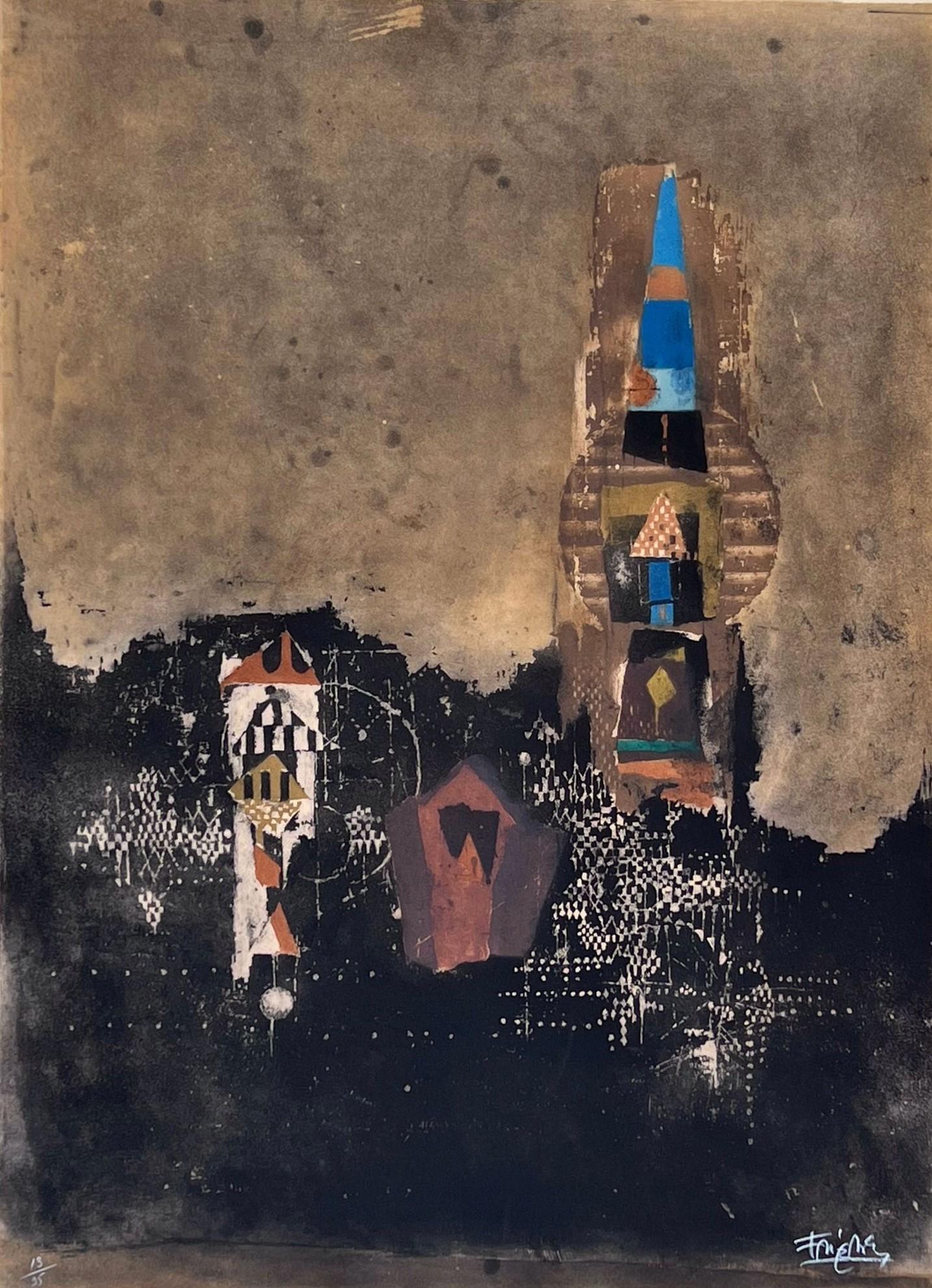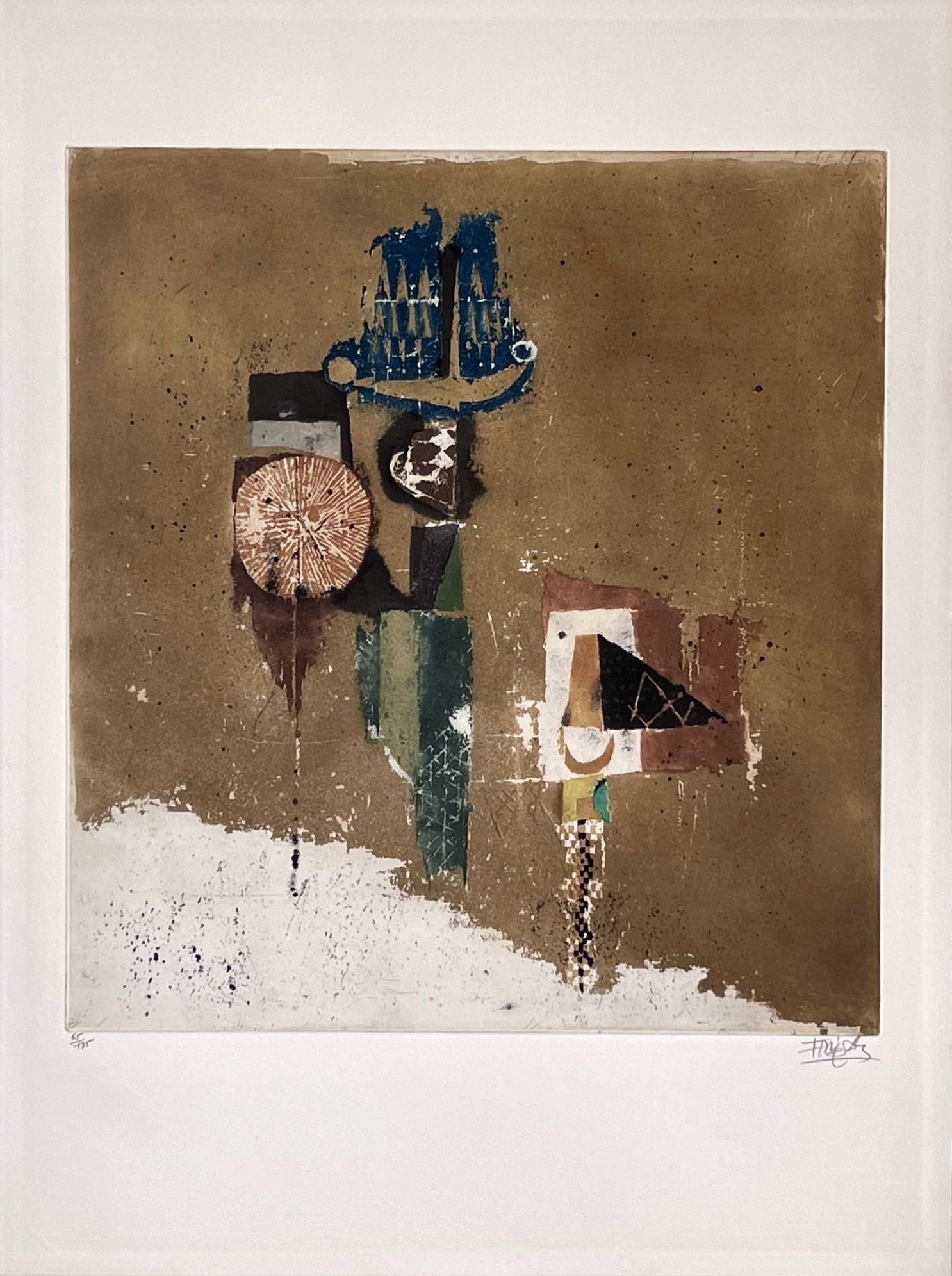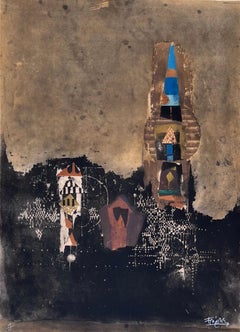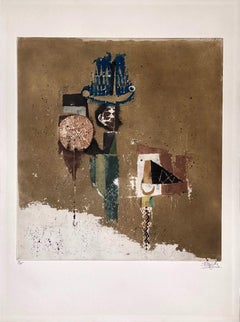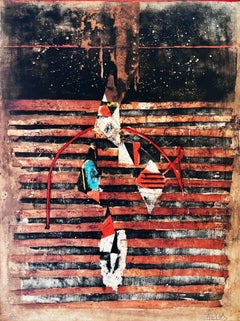Want more images or videos?
Request additional images or videos from the seller
1 of 10
Johnny FriedlaenderAbstract Composition IIc.1970
c.1970
$700
£544.32
€618.90
CA$1,008.50
A$1,102.66
CHF 576.48
MX$13,264.86
NOK 7,294.84
SEK 6,841.91
DKK 4,621.27
About the Item
This artwork "Abstract Composition II." c.1970 in an original color etching and aquatint on Arches paper by noted Polish artist Johnny Friedlaender, 1912-1992. It is hand signed and inscribed Epreuve d'Artiste (Artist Proof) in pencil by the artist. The image (plate mark) size is 21.5 x 16 inches, sheet size is 22.75 x 17.25 inches. It is in excellent condition.
About the artist:
Johnny Friedlaender (26 December 1912 – 18 June 1992) was a leading 20th century artist, whose works have been exhibited in Germany, France, Netherlands, Italy, Japan and the United States. He has been influential upon other notable artists, who were students in his Paris gallery. His preferred medium of aquatint etching is a technically difficult artistic process, of which Friedlaender has been a pioneer.
Johnny Gotthard Friedlaender was born in Pless (Silesia) and his early studies were in Breslau under Otto Mueller. In 1936 Friedlaender journeyed to Czechoslovakia, Switzerland, Austria, France and Belgium. At the Hague he held a successful exhibition of etchings and watercolours. He fled to Paris in 1937 as a political refugee of the Nazi regime with his young wife, who was an actress. In that year he held an exhibition of his etchings which included the works: L ‘Equipe and Matieres et Formes. From 1939 to 1943 he was interned in a series of concentration camps, but survived against poor odds.
After freedom in 1944 Friedlaender began a series of twelve etchings entitled Images du Malheur with Sagile as his publisher. In the same year he received a commission to illustrate four books by Freres Tharaud of the French Academy. In 1945 he performed work for several newspapers including Cavalcade and Carrefour. In the year 1947 he produced the work Reves Cosmiques and in that same year he became a member of the Salon de Mai, which position he held until 1969. In the year 1948 he began a friendship with the painter Nicolas de Stael and held his first exhibition in Copenhagen at Galerie Birch. The following year he showed for the first time in Galerie La Hune in Paris. After living in Paris for 13 years, Friedlaender became a French citizen in 1950.
Friedlaender expanded his geographic scope in 1951 and exhibited in Tokyo in a modern art show. In the same year he was a participant in the XI Trienale in Milan, Italy. By 1953 he had produced works for a one man show at the Museum of Neuchâtel and exhibited at the Galerie Moers in Amsterdam, the II Camino Gallery in Rome, in São Paulo, Brazil and in Paris. He was a participant of the French Italian Art Conference in Turin, Italy that same year.
Friedlaender accepted an international art award in 1957, becoming the recipient of the Biennial Kakamura Prize in Tokyo. In 1959 he received a teaching post awarded by UNESCO at the Museum of Modern Art in Rio de Janeiro. By 1968 Friedlaender was travelling to Puerto Rico, New York and Washington, D.C. to hold exhibitions. That year he also purchased a home in the Burgundy region of France. 1971 was another year of diverse international travel including shows in Bern, Milan, Paris, Krefeld and again New York. In the latter city he exhibited paintings at the Far Gallery, a venue becoming well known for its patronage of important twentieth century artists.
1978 brought a retrospective of Friedlaender's works at the Musee d’Art Moderne de la Ville de Paris. He was awarded the Lovis Corinth Prize in Regensburg three years later. On his 75th birthday, Friedlaender was given a retrospective in the Bremen Art Museum. On his 80th birthday he held a retrospective exhibition in Bonn at the municipal council offices. Friedlaender died in Paris at the age of 89.
- Creator:Johnny Friedlaender (1912 - 1992, Polish)
- Creation Year:c.1970
- Dimensions:Height: 21.75 in (55.25 cm)Width: 17.25 in (43.82 cm)Depth: 0.01 in (0.26 mm)
- Medium:
- Movement & Style:
- Period:
- Condition:
- Gallery Location:San Francisco, CA
- Reference Number:Seller: fried/abs/com/021stDibs: LU66637415092
Johnny Friedlaender
Johnny Gotthard Friedlaender was born in Pless (Silesia) and his early studies were in Breslau under Otto Mueller. In 1936 Friedlaender journeyed to Czechoslovakia, Switzerland, Austria, France and Belgium. At the Hague he held a successful exhibition of etchings and watercolours. He fled to Paris in 1937 as a political refugee of the Nazi regime with his young wife, who was an actress. In that year he held an exhibition of his etchings which included the works: L 'Equipe and Matieres et Formes. From 1939 to 1943 he was interned in a series of concentration camps, but survived. After freedom in 1944 Friedlaender began a series of twelve etchings entitled Images du Malheur with Sagile as his publisher. In the same year he received a commission to illustrate four books by Freres Tharaud of the French Academy. In 1945 he performed work for several newspapers including Cavalcade and Carrefour. In 1947, he produced the work Reves Cosmiques, and in that same year he became a member of the Salon de Mai, which position he held until 1969. In the year 1948 he began a friendship with the painter Nicolas de Stael and held his first exhibition in Copenhagen at Galerie Birch. The following year he showed for the first time in Galerie La Hune in Paris. After living in Paris for 13 years, Friedlaender became a French citizen in 1950. Friedlaender expanded his geographic scope in 1951, and exhibited in Tokyo in a modern art show. In the same year he was a participant in the XI Trienale in Milan, Italy. By 1953 he had produced works for a one-man show at the Museum of Neuchâtel and exhibited at the Galerie Moers in Amsterdam, the II Camino Gallery in Rome, in São Paulo, Brazil and in Paris. He was a participant of the French Italian Art Conference in Turin, Italy that same year. Friedlaender accepted an international art award in 1957, becoming the recipient of the Biennial Kakamura Prize in Tokyo. In 1959 he received a teaching post awarded by UNESCO at the Museum of Modern Art in Rio de Janeiro. By 1968, Friedlaender was travelling to Puerto Rico, New York and Washington, D.C. to hold exhibitions. That year he also purchased a home in the Burgundy region of France. 1971 was another year of diverse international travel including shows in Bern, Milan, Paris, Krefeld and again New York. In the latter city he exhibited paintings at the Far Gallery, a venue becoming well known for its patronage of important twentieth century artists. 1978 brought a retrospective of Friedlaender's works at the Musee d'Art Moderne de la Ville de Paris. He was awarded the Lovis Corinth Prize in Regensburg three years later. On his 75th birthday, Friedlaender was given a retrospective in the Bremen Art Museum. On his 80th birthday he held a retrospective exhibition in Bonn at the municipal council offices. Friedlaender died in Paris at the age of 89.
About the Seller
5.0
Platinum Seller
Premium sellers with a 4.7+ rating and 24-hour response times
Established in 1999
1stDibs seller since 2017
853 sales on 1stDibs
Typical response time: 1 hour
- ShippingRetrieving quote...Shipping from: San Francisco, CA
- Return Policy
Authenticity Guarantee
In the unlikely event there’s an issue with an item’s authenticity, contact us within 1 year for a full refund. DetailsMoney-Back Guarantee
If your item is not as described, is damaged in transit, or does not arrive, contact us within 7 days for a full refund. Details24-Hour Cancellation
You have a 24-hour grace period in which to reconsider your purchase, with no questions asked.Vetted Professional Sellers
Our world-class sellers must adhere to strict standards for service and quality, maintaining the integrity of our listings.Price-Match Guarantee
If you find that a seller listed the same item for a lower price elsewhere, we’ll match it.Trusted Global Delivery
Our best-in-class carrier network provides specialized shipping options worldwide, including custom delivery.More From This Seller
View AllAbstract Composition 9
By Johnny Friedlaender
Located in San Francisco, CA
This artwork "Abstract Composition 9" c.1970 in an original color lithograph on B.F,K. Rives paper by noted Polish artist Johnny Friedlaender, 1912-199...
Category
Late 20th Century Abstract Abstract Prints
Materials
Lithograph
Untitled I
By Johnny Friedlaender
Located in San Francisco, CA
This artwork "Untitled I" c.1970 in an original color aquatint on Arches paper by noted Polish artist Johnny Friedlaender, 1912-1992. It is hand signed and numbered 128/135 in pencil...
Category
Late 20th Century Abstract Abstract Prints
Materials
Aquatint
Abstract Composition VI
By Johnny Friedlaender
Located in San Francisco, CA
This artwork "Abstract Composition VI" 1974 in an original color etching and aquatint on Wove paper by noted Polish artist Johnny Friedlaender, 1912-1992. It is hand signed and numb...
Category
Late 20th Century Abstract Abstract Prints
Materials
Etching, Aquatint
Untitled IV
By Johnny Friedlaender
Located in San Francisco, CA
This artwork "Untitled IV" c.1970 in an original color aquatint on Arches paper by noted Polish artist Johnny Friedlaender, 1912-1992. It is hand signed and numbered 128/135 in penci...
Category
Late 20th Century Abstract Abstract Prints
Materials
Aquatint
Abstract Composition IV
By Johnny Friedlaender
Located in San Francisco, CA
This artwork "Abstract Composition IV" c.1970 in an original color etching and aquatint on Wove paper by noted Polish artist Johnny Friedlaender, 1912-1992. It is hand signed and num...
Category
Late 20th Century Abstract Abstract Prints
Materials
Etching, Aquatint
Untitled II
By Johnny Friedlaender
Located in San Francisco, CA
This artwork "Untitled II" c.1970 in an original color aquatint on Arches paper by noted Polish artist Johnny Friedlaender, 1912-1992. It is hand signed and numbered 128/135 in penci...
Category
Late 20th Century Abstract Abstract Prints
Materials
Aquatint
You May Also Like
Composition III
By Johnny Friedlaender
Located in Paris, FR
Engraving
Handsigned by the artist in pencil
Edition : 13/95
76.00 cm. x 56.50 cm. 29.92 in. x 22.24 in. (paper)
76.00 cm. x 56.50 cm. 29.92 in. x 22.24 in. (image)
Arches paper
A...
Category
1970s Abstract Abstract Prints
Materials
Engraving
Untitled
By Johnny Friedlaender
Located in Paris, FR
Aquatint
Handsigned by the artist in pencil
Edition : 65/135
65.00 cm. x 49.00 cm. 25.59 in. x 19.29 in. (paper)
44.50 cm. x 41.50 cm. 17.52 in. x 16.34 in. (image)
This engraving...
Category
1960s Abstract Abstract Prints
Materials
Aquatint
Hommage, Modern Abstract Aquatint Etching by Johnny Friedlaender
By Johnny Friedlaender
Located in Long Island City, NY
Hommage by Johnny Friedlaenderm German (1912–1992)
Date: circa 1965
Aquatint, signed in pencil
Edition of EA
Size: 30 in. x 22 in. (76.2 cm x 55.88 cm)
Frame Size: 36 x 28.5 inches
Category
1960s Modern Abstract Prints
Materials
Etching, Aquatint
No title
By Johnny Friedlaender
Located in Paris, FR
Engraving
Handsigned by the artist in pencil
76.00 cm. x 55.50 cm. 29.92 in. x 21.85 in. (paper)
76.00 cm. x 55.50 cm. 29.92 in. x 21.85 in. (image)
Annoted "EA"
Certificate of au...
Category
1970s Abstract Abstract Prints
Materials
Engraving
Contrepoints
By Johnny Friedlaender
Located in Paris, FR
Engraving, 1977
Handsigned by the artist in pencil and annoted EA
63.00 cm. x 91.00 cm. 24.8 in. x 35.83 in. (paper)
58.00 cm. x 76.00 cm. 22.83 in. x 29.92 in. (image)
LCD4019
Category
1970s Abstract Abstract Prints
Materials
Engraving
Johnny Friedlaender Abstract Artist's Proof Signed Limited Edition Print
By Johnny Friedlaender
Located in San Rafael, CA
Johnny Gotthard Friedlaender (German, 1912-1992)
'Cadran Solair' (Sun Dial)
Titled verso
Aquatint etching in colors on wove paper
Pencil signed lower right, edition EA (épreuve d'ar...
Category
1960s Abstract Abstract Prints
Materials
Etching, Aquatint
More Ways To Browse
Joan Miro Cantic Del Sol
Joan Miro Homage
Joan Miro Original 1952
Joan Miro Paroles Peintes Iii
Joan Miro Pencil Signed
Joan Mitchell Sunflower
John Chin Young
John Ha
John Walker Abstract Prints
Jordan Ann Craig
Josef Albers Folder 8
Josef Albers Wls
Judith Azur
Junko Mori
Juraj Dobrovic
Kaws The News
Keith Haring Inflatable Baby
Koen Vanmechelen
